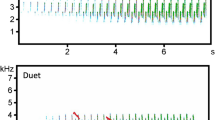Summary
-
1.
Anurogryllus arboreus males in north peninsular Florida sing at ground level or above the ground on the trunks of trees or on other vegetation. Their song is a continuous trill at 70–80 pulses/s and 5.0–5.5 kHz. Prevailing singing locations of individual males vary among and within denies (Fig. 2). Males of congeneric West Indian species sing only at ground level.
-
2.
Females are flightless and climb plants only in response to male calls. Therefore the three-dimensional acoustic output of a male may be of less direct importance than the male'sbroadcast area — the area at ground level within which the intensity of his call exceeds the auditory threshold of the average female.
-
3.
Assuming a threshold of 38 dB (SPL re 2 × 10−5N · m−2) we found that males calling 1 m above the ground had broadcast areas averaging 14 times the broadcast areas of males calling at ground level (119 vs. 1,642 m2) (Fig. 4A-D, Table 1).
-
4.
In terms of broadcast area, the optimal height for singing is influenced by spreading loss at greater heights, by attenuation due to ground cover and low vegetation, and by acoustical shadows due to rough terrain.
-
5.
On vertical surfaces, such as tree trunks, crickets more often (27∶1) sing facing right or left than up or down (Fig. 3) making the broadcast areas asymmetrical (Fig. 4B-D).
-
6.
When crickets singing on vertical surfaces deviate more than 22.5° from the horizontal, they generally (7∶1) angle downward (Fig. 3). Facing downward apparently has no acoustical advantage over facing upward since sound levels behind a cricket calling on the ground are at least as intense as those ahead (Fig. 4E).
Similar content being viewed by others
References
Alexander, R.D., Otte, D.: The evolution of genitalia and mating behavior in crickets (Gryllidae) and other Orthoptera. Misc. Publ. Mus. Zool. Univ. Michigan133, 1–62 (1967)
Bennet-Clark, H.C.: The mechanism and efficiency of sound production in the mole cricket. J. Exp. Biol.52, 619–652 (1970)
Embleton, T.F.W., Percy, J.E., Olson, N.: Outdoor sound propagation over ground of finite impedance. J. Acoust. Soc. Am.59, 267–277 (1976)
Loftus-Hills, J.J., Littlejohn, M.J., Hill, K.G.: Auditory sensitivity of the cricketsTeleogryllus commodus andT. oceanicus. Nature (New Biol.)233, 184–185 (1971)
Marten, K., Marler, P.: Sound transmission and its significance for animal vocalization. Behav. Ecol. Sociobiol.2, 271–290 (1977)
Nocke, Harald: Biophysik der Schallerzeugung durch die Vorderflügel der Grillen. Z. Vergl. Physiol.74, 272–314 (1971)
Otte, D.: Communication in Orthoptera. In: How animals communicate. Sebeok, T.A. (ed.), pp. 334–361. Bloomington: Indiana University Press 1977
Prozesky-Schulze, L., Prozesky, O.P.M., Anderson, F., Morwe, G.J.J. van der: Use of a self-made baffle by a tree cricket. Nature255, 142–143 (1975)
Sokal, R.R., Rohlf, F.J.: Biometry. San Francisco: Freeman 1969
Spooner, J.D.: The Texas bush katydid — its sounds and their significance. Anim. Behav.12, 235–244 (1964)
Walker, T.J.: Experimental demonstration of a cat locating orthopteran prey by the prey's calling song. Fla. Entomol.47, 163–165 (1964)
Walker, T.J.:Oecanthus jamaicensis, n.sp.: aCecropia-inhabiting cricket (Orthoptera:Gryllidae). Fla. Entomol.52, 263–265 (1969)
Walker, T.J.: Systematics and acoustic behavior of United States and Caribbean short-tailed crickets (Orthoptera: Gryllidae:Anurogryllus). Ann. Entomol. Sco. Am.66, 1269–1277 (1973)
Walker, T.J.: Reproductive behavior and mating success of male short-tailed crickets: differences within and between demes. Evol. Biol. (in press) (1979a)
Walker, T.J.: Calling crickets (Anurogryllus arboreus) over pitfalls: females, males, and predators. Envir. Entomol.8, 441–443 (1979b)
Author information
Authors and Affiliations
Additional information
Ms. Michele Russell helped calculate broadcast areas, and Drs. J.E. Lloyd and G.K. Morris criticized the manuscript. The research was supported by NIH Grant 5F32N55312-02CMS and NSF Grant DEB 76-10019. Florida Agricultural Station Journal Series No. 1220.
Rights and permissions
About this article
Cite this article
Paul, R.C., Walker, T.J. Arboreal singing in a burrowing cricket,Anurogryllus arboreus . J. Comp. Physiol. 132, 217–223 (1979). https://doi.org/10.1007/BF00614493
Accepted:
Issue Date:
DOI: https://doi.org/10.1007/BF00614493




